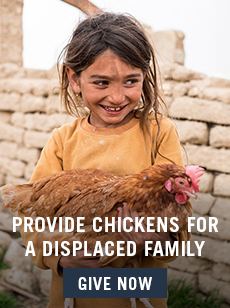
The only bad failure is the one from which we fail to learn.
Most organizations put a premium on celebrating successes at the end of every year—we certainly do!
But we also believe that we have a great deal to learn from our failures, so we endeavor to share them and the lessons we’ve learned in hopes of avoiding those same mistakes in the future.
When seeking to tackle intractable problems in an environment like Iraq, missed opportunities, missteps, false starts, and failures are par-for-the-course. There will be no improvement in the political situation in Iraq, in the economy, in healthcare, or in the pursuit of peace without a number of flops and failures along the journey. If we already knew what worked, we all would’ve implemented it by now and moved on.
The truth is, neither the American government nor the Iraqi—neither international nor local NGOs—truly know what works in Iraq. Most of us are making educated guesses and seeking to rightly adapt programs and principles that have proven successful at other times in Iraq or in other parts of the world.
From this point forward, I want to provide you with an annual (and sometimes real-time) assessment of our failures. In absence of such previous reports, I will use a few minutes to highlight our most meaningful setbacks, failures and lessons learned to date.
The three major failures of 2011, to be covered in this series of reports are:
Failure #1: Leadership Indecisiveness on the Case of Six-Year-Old Yahya (Read about Failure #1 here)
Failure #2: High-mortality Remedy Missions in February/March 2011
Failure #3: The Loss of Our Sulaymaniyah, Iraq Surgery Site as a Major Developmental Partner; Lack of Surgical Capacity Increase As a Result of Remedy Missions Conducted
Let’s get started…
2011 Failure #2: High-mortality Remedy Missions in February/March 2011
In February and March we ran two back-to-back Remedy Missions. One was our second in the southern city of Nasiriyah; the other was our second in the northern city of Sulaymaniyah.
Over the course of four weeks of surgery, mortality rates between the two cities reached 20.5% (7 deaths out of 34 operations).
A few of the losses were very surprising to many on the local and international team and had an extremely demoralizing effect on the team (particularly in Sulaymaniyah). The loss of momentum undoubtedly had a qualitative impact on the care provided as the trip progressed.
Some of the factors were anomalous, such as our lead surgeon contracting an infection in a wound on his ankle that resulted in impromptu surgery inside Iraq to save his leg. But other factors were almost certainly preventable, beginning with case selection and moving to fundamental deficiencies in the hospital equipment and protocols themselves.

A lack of warming blankets, portable oxygen units, a ready blood bank and several other fundamentals led to a less-than-ideal environment for the teaching of pediatric cardiac care. As a result of all these factors and the inherent difficulties of open-heart surgery, mortality rates in the Sulaymaniyah mission reached 22% (four deaths)—unacceptably high by any standard.
None of the deaths were considered “surgical” deaths, in the sense that the child did not die on the operating table, but rather in the post-operative intensive care unit, ward, or—in one case—in the car on the way home after being prematurely discharged by a local nurse the day the international team left the country.

Lessons Learned:
Our international team was very impressed with the local cardiologist for Remedy Mission II in the southern city of Nasiriyah. When it came time to schedule Remedy Mission III in that city, the decision was apparently made to not send a cardiologist on the mission, believing that the local team could handle it. This may have contributed to the imbalanced case selection in RM III and may have led to the situation in which three children died during the course of the mission.
Since that mission, an international cardiologist has been present on every Remedy Mission in an effort to help with case selection and create a balanced schedule of surgeries.
In Sulaymaniyah for Remedy Mission IV, case selection was complicated by the number of stakeholders in the mission. Children were formally and informally (that is, “politically”) put into the mission by the Preemptive Love Coalition, local cardiologists and surgeons, Kurdistan Save the Children (a local NGO), and the Health Directorate.
With regard to Yahya’s case, as described before, I can certainly say that my judgement was impaired when it came to case selection. I can speculate that other entities, in an effort to do right by the friends and patients on their lists, made similar errors in judgement that ultimately skewed the balance of the surgery schedule and its complexities.
When two children died in Sulaymaniyah after the international team left for the airport, we realized for the first time how ill-equipped the local team was to handle relatively simple post-operative care (one child had a positive prognosis in the ICU and the other was already out of ICU and recovering in the ward).
In our post-mission Impact Evaluation Report, we published the following statement:
Our post-mission conferences and deliberations on the matter resulted in the following protocols:
1. A mandatory reduction in “RACHS-1 scores” presented to the international team by the local team
2. A mandatory international ICU team to be left behind after surgeries stop to stave off post-mission ICU deaths and errant discharges
3. A postponing of our next planned mission to the Sulaymaniyah Center for Heart Disease due to lack of preparation of materials, equipment, staff, and protocols
If you have any questions or concerns about this report, the decisions we’ve made, or the direction we are going, please email me at your convenience. I would love to hear from you.
